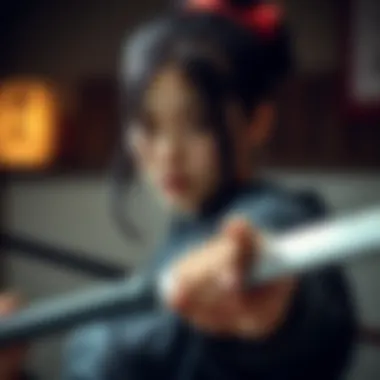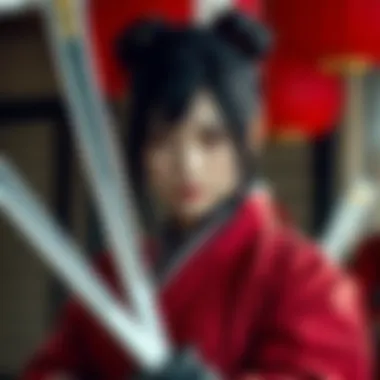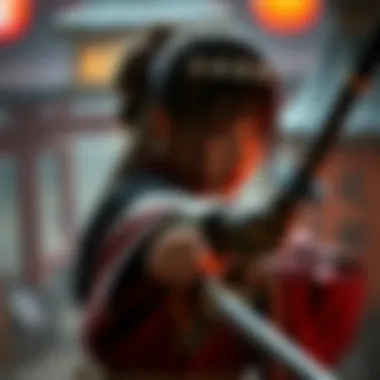The Training and Legacy of Kunoichi in Japan


Intro
The complexity of kunoichi—the female ninjas of Japan—opens up a world that is rich in history and cultural significance. This article aims to chart the course of these remarkable women through the lens of their training, skills, and the multifaceted roles they occupied in society, both in ancient Japan and in modern representations. While many may think of ninjas as cloaked figures slipping through shadows, the reality is anything but simplistic. These women were trained in various disciplines that extended beyond mere stealth, encompassing martial arts, strategy, and even the arts of persuasion.
Kunoichi not only played integral roles in espionage; they were also key in shaping the perception of women within the martial arts and broader social contexts. Today's popular media, from anime to movies, often glamorizes their image, though the narratives may skew their realities. By grappling with both historical documents and present-day depictions, we aim to offer a nuanced understanding of how kunoichi fit into the larger tapestry of Japanese culture.
In the following sections, we will delve deeper into their historical training methodologies, societal roles, and how they continue to be relevant in contemporary discussions. So, whether you're an anime aficionado or a tech enthusiast intrigued by how technology intersects with folklore, this exploration of kunoichi promises to be both revealing and enlightening.
Training and Skill Development of Kunoichi
Kunoichi training was extensive, often beginning at an early age. Unlike their male counterparts, who typically engaged in more overt forms of combat training, the education of a kunoichi was often clandestine and intricate. They learned skills that were essential not just for ninjutsu but also for espionage tasks.
Key areas of training included:
- Martial Arts: Proficient in various forms of combat, kunoichi were generally skilled in both armed and unarmed techniques. Weapons like shurikens (throwing stars) and kunai (fixed-blade knives) became extensions of their will.
- Stealth Tactics: Learning how to move unseen, kunoichi trained in techniques that would aid them in infiltrating enemy territories without detection. This often included understanding natural sounds and rhythms.
- Disguises and Seduction: Kunoichi often posed as commoners, and their training included skills in impersonation and the arts. They would master various crafts or social skills to blend seamlessly into civilian life.
A typical day of training might look like this:
- Early morning drills in physical conditioning.
- Practice with weapons, focusing on accuracy and speed.
- Stealth practices outdoors, using natural cover.
- Evening lessons in strategy and psychology, often emphasizing the importance of reading opponents.
"The effectiveness of a kunoichi lay not just in her physical abilities, but in her mind."
Understanding the tactical as well as psychological dimensions of their training shaped kunoichi's roles, making them not only fighters but also strategists.
Top Anime APK Recommendations
Given the cultural resurgence of kunoichi in anime and other media, many fans may want to explore this world through various channels. Here are a few recommendations:
- Crunchyroll: This is a go-to platform for streaming the latest episodes of various anime. With many shows featuring kunoichi characters, it becomes a hub for enthusiasts.
- Funimation: A solid choice for dubbed content, this platform offers both classic and contemporary series, ensuring fans don't miss out on any narratives involving female ninjas.
- Manga Rock: While not purely for anime, this app provides a vast repository of manga where you can find stories focusing on kunoichi.
End
As we look forward to the final sections of this exploration, it's important to recognize how the story of kunoichi transcends time and medium. From their rigorous training in the shadows of history to their vibrant portrayals in anime and manga today, these women are much more than myths. They represent the strength, intelligence, and adaptability that challenge the stereotypes surrounding female figures in historical narratives.
With this foundation laid, the subsequent sections will delve into the contemporary interpretations and social implications of kunoichi in our society today.
Foreword to Kunoichi
The exploration of kunoichi invites readers into a unique segment of Japanese history, revealing the hidden dimensions of female ninjas who played pivotal roles in espionage and warfare. Understanding the concept of kunoichi is crucial, as it unearths not only historical narratives but also cultural values and societal dynamics that shaped Japan from the feudal era to modern times. This introduction aims to elucidate their significance by examining the complexities of their training and skills, thus setting the stage for a nuanced analysis.
Definition and Historical Context
Kunoichi refers to the female ninja, a term that has evolved over centuries. Historically, these women were not merely passive figures but active participants in the strategic frameworks of their clans. They were trained in various forms of combat, stealth, and intelligence-gathering, contributing essential abilities that differed from their male counterparts. In their world, the line between life and death often blurred, prompting rigorous training regimes tailored to hone their skills.
In the context of feudal Japan, women often had predefined roles, predominantly centered around domestic life. However, amidst the turmoil of feudal conflicts, some women stepped outside these bounds, donning the role of kunoichi. They infiltrated enemy strongholds, gathered intelligence, and executed daring missions. Names of reputed kunoichi like Mochizuki Chiyome and Kunoichi Yagyu have echoed through the annals of history, symbolizing resilience and tactical acumen.
"While the world often paints the image of the masculine warrior, the kunoichi exemplifies a powerful narrative of strategy and subtle strength."
The period of the Sengoku era especially witnessed the rise of these female warriors, reflecting an environment where their training methodologies were heavily influenced by cultural norms and the necessity of survival. Thus, investigating the historical context gives a comprehensive insight into the societal factors that birthed the kunoichi phenomenon.
Cultural Impact of Kunoichi
The legacy of kunoichi extends beyond warfare into the realm of cultural identity and representation. They symbolize the often-overlooked contributions of women in narratives surrounding Japanese history, granting a voice to those who maneuvered within the shadows. This impact is multifaceted, inspiring countless adaptations in literature, anime, and contemporary media.


In the context of popular culture, kunoichi have transitioned from historical icons to figures emblazoned in fantasy and media narratives. They are often portrayed as enigmatic assassins or fierce warriors, capturing the imaginations of audiences globally. Such depictions come with the dual responsibility of honoring their historical roots while engaging in creative reinterpretation. This balance between facts and myths has sparked discussions on gender roles, representation, and the evolution of the image of women in martial roles.
Furthermore, their portrayal in modern settings challenges existing narratives about women's capability in traditionally male-dominated fields like combat and espionage. As anime fans and cultural enthusiasts explore these themes, they enrich their understanding and appreciation of historical figures who, despite their complexities, embody strength and subtlety in every tale.
Training Techniques
The training techniques employed by kunoichi were not mere exercises in physical prowess; they were intricate methodologies designed to hone their skills for espionage and survival. The indispensable training regimens combined physical and mental conditioning, ensuring that these women were well-prepared to tackle the multifaceted challenges of their missions. Understanding these techniques opens a window into the lives of kunoichi and the societal norms they navigated.
Physical Training Regimens
Martial Arts
Martial arts served as the bedrock of a kunoichi's physical training. Unlike their male counterparts who might have focused on brute strength, kunoichi often concentrated on agility and precision. The essential characteristic of martial arts in their training was the emphasis on fluid movement, flexibility, and stealthful technique rather than raw power. This choice was particularly advantageous as it allowed them to blend into their environment rather than stand out.
A unique aspect of martial arts training was the integration of weapon usage. Kunoichi often trained with tools like shuriken and nunchaku, which required not just skill but also deep mental awareness of their surroundings. The downside, however, was that this training could be physically grueling, demanding longer hours and greater dedication to master the techniques adequately.
Agility and Stealth Techniques
In addition to martial arts, agility and stealth techniques played a crucial role in the training of kunoichi. These methods were essential for developing skills in slipping past guards undetected or evading capture. The ability to move silently and quickly was not just beneficial; it was a means of survival.
Agility training often involved balancing exercises, parkour-style movements, and even acrobatics. This unique feature of their training ensured that kunoichi could navigate various terrains, whether in dense forests or urban environments. The downside, though, lay in the potential for injury. Many mothers would express concern when their daughters trained, worrying about falls and strains sustained during practice. However, the advantages far outweighed the risks, as mastery of these techniques often meant the difference between life and death during missions.
Mental Conditioning and Strategy
Psychological Training
The psychological aspects of training were just as pivotal as the physical ones. Psychological training focused on instilling resilience, ensuring kunoichi could handle extreme stress and make quick decisions under pressure. Such training included mental exercises to sharpen their focus and techniques to combat fear and doubt. As a key characteristic, this form of training filled in the gaps often overlooked in traditional martial training.
It was also a beneficial choice because it prepared the kunoichi for the unpredictable nature of their roles. A unique feature of this training was its adaptability; psychological strategies varied according to the mission's specific dangers and required mindfulness techniques that might incorporate meditation or tactical breathing exercises. The disadvantage, though, could be the emotional weight of such training, as it often forced them to confront fears they wished to avoid.
Tactics and Espionage
The tactical training made for kunoichi was deeply intertwined with the art of espionage. This training laid out strategies for gathering intelligence, analyzing enemy weaknesses, and planning executions of complex missions. A hallmark of this instruction involved role-playing scenarios that sharpened their ability to think on their feet.
This was a popular choice since successful espionage frequently hinged on one's ability to outwit and manipulate. The advantages here include enhanced problem-solving skills and superior strategic thinking. However, the pressures of such training can weigh heavily on the kunoichi, leading to dilemmas about morality and duty.
Cultural Teachings and Values
Role of Women in Society
The training of kunoichi existed within a broader societal framework where the perception of women was complex and often contradictory. Women were expected to fulfill traditional roles, yet kunoichi defied these norms through their specialized skills and agency. Their training embodyed a unique characteristic that showcased women's potential beyond domestic spheres.
The emphasis on strategic thinking not just benefited their roles as spies but also positioned them as critical players in family and community dynamics. Yet, navigating these roles came with the disadvantage of societal expectations, which were at times conflicting for women stepping outside conventional boundaries.
Historical Context of Training
Understanding the historical context of kunoichi training provides a clearer picture of the societal influences that shaped their roles. The training methods reflected both the hierarchical structure of feudal Japan and the necessity for women to engage in subterfuge and protection of their families. This aspect made their training not only relevant but essential to their survival and contribution in a patriarchal society.
The unique feature of this historical context highlighted how cultural beliefs shaped training, which emphasized adaptability, nuanced understandings of combat, and survival techniques. The downside, perhaps, was the limited recognition given to their contributions, overshadowed often by the glorified tales of male warriors. Understanding these intricate layers reveals much about the true essence and sacrifices of the kunoichi.
Skills of a Kunoichi
The skills of a kunoichi aren't just the stuff of legends; they represent a blend of physical prowess, mental agility, and dubious charm that make these women formidable figures in both the shadows and society. The importance lies deeply in their multifaceted capabilities. Kunoichi were capable of more than mere stealth missions or impactful combat; they were strategic thinkers, often influencing social dynamics beyond the battlefield. Enhancing their efficacy in espionage, their skills equipped them to navigate the often treacherous waters of feudal Japan. Below is a deep dive into the essential skills of these enigmatic women.
Stealth and Infiltration


Stealth was a cornerstone of the kunoichi's arsenal. The ability to move undetected was not merely a benefit; it was often a matter of life and death. Kunoichi employed techniques such as silent movement learned through careful training in woodlands and urban settings, ensuring they could enter enemy territory without leaving a trace. For example, they might utilize the cover of night or the bustle of a crowded market to slip in unnoticed.
Uncommon strategies included
- Disguises: Kunoichi often blended into local communities, employing the art of disguise to gather intelligence without revealing their true intentions.
- Psychological Tactics: They understood how to manipulate perceptions. For instance, a kunoichi might choose to change her demeanor or even her accent to match that of the locals.
Stealth is the art of partaking in the shadows, not merely being absent; it's the mastery of presence without imprint.
Combat Skills
In a world rife with danger, each kunoichi was often trained in combat skills that went beyond the ordinary. They mastered various martial arts, but their training was distinct, focusing on agility, reflexes, and improvisation. Kunoichi frequently utilized weapons like shuriken but also favored more close-quarter combat techniques—their petite stature often allowed for agility and quick escapes.
Some notable combat techniques included:
- Aikido: Utilizing the opponent’s force against them, a kunoichi could turn a strong assailant's momentum to her advantage.
- Ninjutsu: Foundation training that enhanced physical abilities alongside tactical planning, offering an edge in fight scenarios.
They were not solely dependent on brute strength; rather, their style strikingly embraced finesse and cunning.
Strategic Intelligence Gathering
A significant part of a kunoichi's role was rooted in intelligence gathering, far more than just physical engagements. This skill set laid the foundation for successful missions, playing into the art of information warfare. They often strategized to infiltrate enemy ranks, gathering necessary intel that could change the course of battles and alliances.
Key aspects of these intelligence-gathering techniques included:
- Networking: Establishing relationships within enemy states to gather information discreetly.
- Observation: Training in keen observation techniques, which included understanding body language, social cues, and politics, helping them decipher enemy plans or intentions.
The ability to harness information effectively was not just a skill but an art. Kunoichi were often instrumental in shaping outcomes based on the intelligence they procured. Thus, the importance of these skills cannot be overstated; they were vital for survival and success in uncertain times.
To explore further into this fascinating blend of stealth, combat, and strategy, visit resources like Wikipedia or Britannica.
Kunoichi in Society
The role of kunoichi in historical contexts extends far beyond mere tools for espionage and combat. While their stealthy skills are often celebrated, the societal contributions of these women are just as remarkable. Kunoichi have shaped not only the battlefield but also the emotional and social fabrics of their time. Recognizing these broader roles underlines the complexity of their existence. They were not simply fighters; they acted as key players in various aspects of society, often navigating layers of cultural norms and expectations.
Roles Beyond Espionage
Mediators
Kunoichi served as mediators, a role that may not be immediately apparent but is crucial in understanding their societal implications. As women who possessed unique knowledge of both martial and social arts, they often acted as bridges during conflicts. Their skills in communication and negotiation, coupled with their ability to read situations, made them particularly adept at diffusing tensions between factions.
A key characteristic of kunoichi mediators is their distinct position. They were seen as figures of trust, capable of expressing the needs and desires of one party while also considering the perspectives of the other. This role was not only beneficial but necessary in a society where women could often be overlooked.
The unique feature of this mediation is that it frequently blended subtlety with strength. While their physical prowess allowed them to command respect, their finesse in handling interpersonal dynamics fostered dialogue and understanding. This balance hurts the notion that women belong solely in the margins of history; rather, they became crucial in the interplay of power.
Advantages of kunoichi as mediators include their ability to navigate male-dominated spaces, often leading to resolutions that might have otherwise spiraled into conflict. However, there is a disadvantage: their success sometimes depended on the perceptions of the men in power, which may have limited their positions in more formal roles.
Healers
Another significant role of kunoichi was that of healers. This aspect emphasizes their multifaceted abilities. In a time when medical knowledge was rudimentary, kunoichi were often seen as repositories of herbal remedies and traditional healing practices. Their education in the medicinal arts was, at times, as extensive as their training in combat.
The defining characteristic of kunoichi healers is their holistic approach to care. They treated not only physical wounds but also understood the psychological toll of conflict. Through their nurturing nature, they fostered recovery, both in body and spirit, for soldiers and villagers alike.
One of the unique features of the healing role is its inherent respect in society. Healers were revered, as the community relied on their knowledge for survival. This acknowledgment often granted kunoichi a level of authority that transcended the restrictive norms of their time. They held a position of esteem, capable of influencing others through empathy and expertise.


However, the limitation here lies in the fact that their role, while respected, often remained confined within the domestic sphere. In male-oriented military roles, their contributions as healers were sometimes overshadowed, which perpetuated a cycle of underrepresentation.
Perceptions of Women in Feudal Japan
Exploring perceptions of women in feudal Japan reveals how cultural views influenced the life and role of kunoichi. These perceptions were often steeped in contradiction; on one hand, women were valued for their nurturing roles, while on the other, they were restricted from political or social power. The kunoichi, with their significant skills and knowledge, defied the broader narratives of female inferiority. They exhibited resilience and adaptability, navigating a society trapped in its own paradoxes.
The duality of admiration and restriction illustrates the complex layers of the society that kunoichi inhabited. It’s essential to appreciate how these women pushed against boundaries, offering both aid and challenges to the norms of their day. Thus, the study of kunoichi invites a broader examination of gender, power, and agency in historical contexts, presenting a rich tapestry of interactions that shaped Japan's feudal landscape.
"Kunoichi were not just shadowy figures of espionage; they were pivotal in diplomatic negotiations and societal healing, embodying strength in every facet of life."
Modern Interpretations of Kunoichi
The way modern society views kunoichi has evolved dramatically over the years. Where once these skilled female ninjas were shrouded in mystery and often relegated to shadows, now they take center stage in various forms of contemporary media. This section digs into the significance of their portrayals today and how they reflect broader cultural narratives.
Depictions in Popular Culture
Anime
Anime has become a dominant force in how kunoichi are portrayed. Characters like Tsunade from Naruto exemplify the strength and diversity of female ninjas. The vibrant art style of anime allows creators to push the boundaries of imagination while showing resilience and skill. Particularly, anime tends to emphasize emotional depth, making these characters relatable to audiences.
One unique feature of this medium is its ability to blend action with personal narratives, providing a multifaceted view of the kunoichi. This creates a richer context, allowing viewers to appreciate both the action-packed sequences and the internal struggles faced by such characters. However, on the flip side, it can also lead to stereotypes, where female characters are overly sexualized. Thus, while anime benefits from its broad appeal and creativity, it can present challenges in how these characters are perceived.
Manga
Manga has its own charm when it comes to detailing the lives of kunoichi. Here, the static art allows for intricate storytelling and character development that often dives deeper than what anime can achieve in motion. Titles like Kunoichi Tsubaki no Mune no Uchi provide viewers insight into the daily lives, challenges, and societal expectations placed on female ninjas.
The key characteristic of manga lies in its pacing and depth, allowing for narratives to develop slowly, creating a rich tapestry of the kunoichi's experiences. This medium often highlights themes of bravery, self-discovery, and the struggle against societal norms. However, the waiting period between chapters can leave fans yearning for more, making this sometimes an advantage, but also a source of frustration for avid readers.
Movies
Movies present a more global interpretations of kunoichi, showcasing them in both mainstream blockbusters and independent films. For instance, in films like Ninja Assassin, the kunoichi is depicted with an edgy flair, embodying strong, almost mythical attributes that capture audience imaginations. Movies typically utilize visual storytelling, making the combat and espionage aspects even more thrilling to watch.
A significant advantage here is that films can reach a broader audience through cinematic techniques, often employing star power to attract viewers. However, this can sometimes lead to a dilution of the respectful, nuanced portrayals that manga or anime can offer. In trying to draw in the crowds, the complexity of the kunoichi's character may be compromised for more sensational content.
The Influence on Contemporary Media
The representation of kunoichi in various media forms has inspired conversations around gender roles, empowerment, and the capabilities of women in traditionally male-dominated spaces. These portrayals have shifted perceptions not only of historical figures but also of women's roles in society today. Their legacy resonates through animated series, graphic novels, and films, influencing a whole new generation to view these female warriors not merely as shadows of their male counterparts but as powerful figures in their own right.
Kunoichi in Video Games
In the realm of video games, kunoichi characters often embody agility and combat skills, serving as integral parts of the gameplay. Titles such as Ninja Gaiden and Tenchu present kunoichi not only as combatants but also as key strategists in missions. The gaming community enjoys the complexity that these female characters bring into the narrative, challenging players to think beyond basic fighting mechanics. While there’s occasionally a tendency towards stereotypes in character design, the evolving nature of storytelling in video games offers new layers to explore. This adaptation of kunoichi in games further solidifies their place in contemporary media, with their stories echoing the historical significance they once held in feudal Japan.
The continual reimagining of kunoichi in media emphasizes their resilience and adaptability, showcasing that their stories are far from over.
The End
The journey of exploring the role and training of kunoichi offers a rich tapestry of insights that are both historically significant and culturally resonant. Kunoichi, the female ninjas of Japan, stand as a testament to the multifaceted roles women have played in society, extending far beyond mere espionage.
Reflections on the Legacy of Kunoichi
The legacy of kunoichi is complex. They were not just spies cloaked in the shadows; they embodied resilience and skill in a male-dominated world. By examining their contributions, we understand how these women navigated societal constraints, often using cunning and intelligence to establish their place in history. The narratives depicted in historical records reveal that their training was not merely physical, but also rooted in cultural teachings that emphasized adaptability and resourcefulness.
Moreover, the portrayal of kunoichi in modern media, particularly in anime and manga, demonstrates a continued fascination with their mystique. These representations often amplify and romanticize their skills, making them icons of strength and independence. This duality—being both warriors in their right and cultural icons—adds layers to our understanding of their place in both historical and contemporary discussions.
Future Perspectives and Research
Looking ahead, the study of kunoichi invites further exploration and research. There are gaps in our understanding of their precise roles in feudal Japan that could be illuminated by diving deeper into archival materials. As contemporary media continues to evolve, new interpretations of kunoichi in films and video games could yield fresh perspectives on their historical significance.
Scholars and enthusiasts alike should also focus on the intersection of gender studies with historical narratives surrounding kunoichi. By doing so, we can gain a broader understanding of how the roles of women have been represented across different cultures and eras. Encouraging academic discourse and maintaining curiosity about the kunoichi will pave the way for richer insights and more nuanced discussions.
In summary, acknowledging the legacy and potential future of kunoichi not only honors their past but also allows us to re-evaluate women's contributions in various spheres, giving them the recognition and respect they rightfully deserve. Acknowledging their skills, their sociocultural impact, and their ongoing influence in media can significantly shape the narrative surrounding female empowerment.











